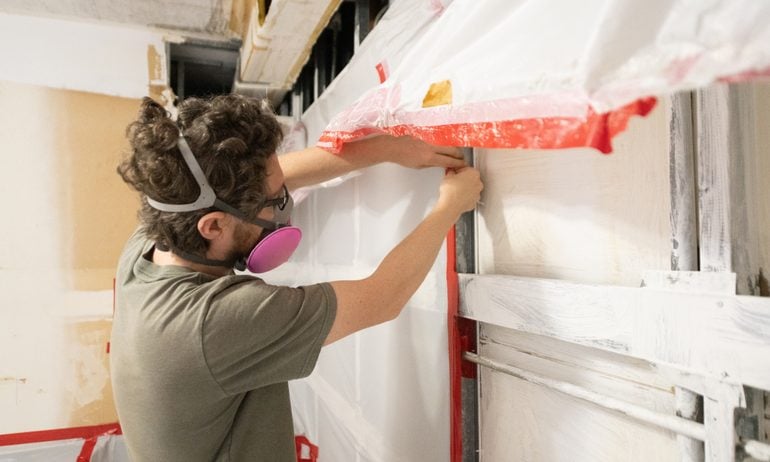How to File a Homeowners Insurance Claim
Filing a home insurance claim in a timely fashion can put money in your pocket faster.

Many, or all, of the products featured on this page are from our advertising partners who compensate us when you take certain actions on our website or click to take an action on their website. However, this does not influence our evaluations. Our opinions are our own. Here is a list of our partners and here's how we make money.
Maybe it's a loud crash overhead. Maybe it's shattering glass. Maybe it's a steady drip of water from your kitchen ceiling. Any of these sounds could mean you quickly need to learn how to file a home insurance claim.
You can't just kick back and wait for your insurance company to pay up. You’ll have to report the issue promptly, keep track of all expenses and communicate with the insurer to make sure you get paid in full for your homeowners insurance claim. Here are seven tips to help make the process easier.
1. File your home insurance claim immediately
Depending on your insurer, you may be able to submit home insurance claims online, through an app, via your agent or by calling the company. No matter which method you choose, reporting a claim right away can put money in your pocket faster.
Once your insurer receives your claim, it will assign a claim number and send an adjuster to assess the damage. Shortly after, the insurance company will issue an initial payment — minus your deductible — to cover the estimated cost of repairs.
If your claim occurred because of storm damage, it's likely other homes in the area were also affected. That means there will be more claims and greater demand on your insurer. Submitting a claim immediately can help get you close to the front of the line.
2. Document the damage
Taking photos and creating an inventory of damaged items gives you and your insurer a record of everything that needs to be repaired or replaced. The more information the insurer has, the better — so try to get pictures of labels and model numbers, especially for more expensive items. Here’s how to create a home inventory.
3. Make temporary repairs
If you have a hole in your roof, you don't have to live with it until the adjuster arrives. Once you've documented the damage for your insurer, you can make temporary repairs if it's safe to.
Whether it's stopping a leak or boarding up a broken window, stopgap repairs can prevent further issues and save time and money. If you don't take steps to fix an immediate problem and the insurer thinks you could have, you might not be fully covered. Say you don't board up a broken window and someone climbs through and steals a TV. Your insurance company might not pay for it.
As long as you keep receipts and can document why the repairs were needed, you can submit the expenses to your insurer as part of the claim.
4. Communicate with your adjuster
Your insurance company will appoint an adjuster to handle the claim, and that person will be your primary point of contact throughout the process. You'll want to detail the damage for them, answer any questions they have, provide documentation of expenses and update them on the status of repairs.
You’ll need to be your own biggest advocate. Remember, the adjuster represents the insurance company's interests, not yours.
"Be politely assertive" with the adjuster, says Amy Bach, executive director of United Policyholders, a nonprofit and advocate for people with insurance. "Don't come in with boxing gloves ready to fight."
You also can hire a public insurance adjuster; they'll manage the claim for you as the policyholder and advocate on your behalf with the insurer. In exchange for their expertise, you'll typically pay a public adjuster a percentage of the final claim amount. This can range from 5% to 20%, depending on where you live and the size of the claim.
5. Save your receipts
You could spend a lot of money on temporary repairs before receiving a payment from your insurance company. If you receive a check from the insurer upfront, you'll still need to save all receipts — estimates won't cut it. The initial payment typically doesn't cover the full cost of repairs. If you want to get paid back in full, you'll need to prove what you actually spent.
6. Consider your contractor
If your home is damaged, you don’t have to use the insurance company’s recommended contractor to do the repairs. Bach says insurers tend to bring in companies they frequently partner with. However, you can always get cost estimates from other contractors on your own.
Before you hire someone, we recommend doing your research by reading reviews from previous customers and checking their Better Business Bureau listing. You may also want to look up the contractor on your state licensing agency’s website. Depending on the state, licensed contractors may be required to have insurance, undergo certain types of training and comply with local building codes. (Note that not all states require contractors to be licensed.)
7. Get help with living expenses
If your home is so badly damaged that you can’t live in it, your insurance company may be able to help. Loss of use coverage is part of a standard homeowners policy and will pay for things like hotel stays and restaurant meals if you can’t live at home. Again, you’ll want to keep all receipts to make sure you’re fully reimbursed for this part of your homeowners insurance claim.


